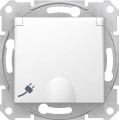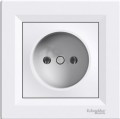In box
—
Socket (module assembly). The assembled module assumes the use of both an electrical contact group and a decorative panel (front frame). Some sockets are additionally equipped with a mounting box. Assembled sockets are completely ready for installation in a mounting box. Electrical fittings of this type are convenient in that when choosing it, there is no need to separately select the front decorative panel.
—
Socket without a frame. Sockets without a frame are equipped with an electrical contact group and a front decorative panel, and the user must order the front decorative frame separately. Usually, frameless sockets are ordered when certain requirements are imposed on the design of electrical fittings. Thus, the customer has the opportunity to choose the version of the front panel that will most successfully harmonize with the interior of the room where the socket will be mounted. Manufacturers of frameless sockets also offer a wide range of individual faceplates that are fully compatible with the electrical contact group.
—
Mechanism only. The socket is represented only by an electrocontact group and is devoid of a front decorative panel. This option is more suitable for cases where the user already has a front panel that is fully compatible with the design of the electrocontact group. Some socket manufacturers offer a wide selection of front de
...corative panels for their products, so you can choose various lining options for a separately sold electrical contact group. In this case, the user has the choice of which decorative panel to install on the socket so that its design matches the interior of the room.Grounding
Sockets with grounding are intended for maintenance of industrial machinery and other equipment. The plug of equipment that requires grounding has an additional contact surface (grounding). Thanks to grounding, the socket protects the serviced equipment from short circuits and other power outages. To install models of this type, it is necessary that the electrical switchboard is equipped with a working ground terminal, and the power cable has an auxiliary conductor connected to ground in the switchboard.
Protective shutters
Protective shutters block free access to the electrocontact group. To use an outlet with curtains, the user must first remove the curtains themselves. Models of this type are mainly intended for installation in facilities where there are small children. Protective curtains prevent cases when a child sticks thin metal objects (hairpins, needles, knitting needles, etc.) into the plug holes.
Protective cover
The protective cover significantly increases the degree of tightness of the outlet. Models with a protective cover are often installed outdoors, as well as in rooms with high humidity (bathrooms and shower rooms, for example). Additionally, the cover allows you to protect curious children from the electrical contact group of the socket. Usually, the protective cover is equipped with a torsion spring, which allows it to be pressed against the front panel with a sufficiently high force.
Embedding depth
The insertion depth of the socket must correspond to the depth of the mounting box. Usually, the standard installation depth is 40 mm. But there are models with both smaller and larger installation depths. For example, narrow sockets require only 25 mm depth from the back box. Additionally, there is a series of sockets that require at least 60 or even 80 mm depth from the mounting box.
Frame thickness
This parameter is applicable to built-in electrical fittings. The thickness of the frame determines how much the outlet will protrude from the wall. In the average model, this figure is in the range of 7-10 mm. The thinner the frame, the more neat the socket will look.

